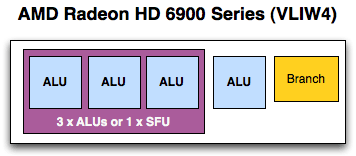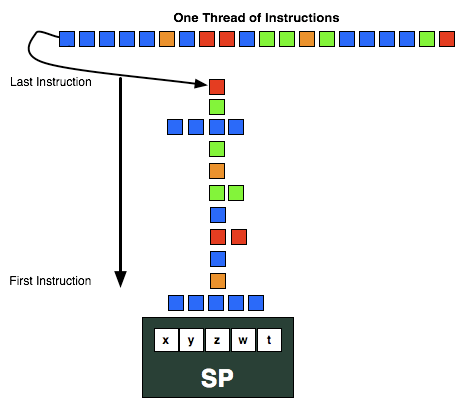AMD's Graphics Core Next Preview: AMD's New GPU, Architected For Compute
by Ryan Smith on December 21, 2011 9:38 PM ESTPrelude: The History of VLIW & Graphics
Before we get into the nuts & bolts of Graphics Core Next, perhaps it’s best to start at the bottom, and then work our way up.
The fundamental unit of AMD’s previous designs has been the Streaming Processor, previously known as the SPU. In every modern AMD design other than Cayman (6900), this is a Very Long Instruction Word 5 (VLIW5) design; Cayman reduced this to VLIW4. As implied by the architectural name, each SP would in turn have 5 or 4 fundamental math units – what AMD now calls Radeon cores – which executed the individual instructions in parallel over as many clocks as necessary. Radeon cores were coupled with registers, a branch unit, and a special function (transcendental) unit as necessary to complete the SP.

VLIW designs are designed to excel at executing many operations from the same task in parallel by breaking it up into smaller groupings called wavefronts. In AMD’s case a wavefront is a group of 64 pixels/values and the list of instructions to be executed against them. Ideally, in a wavefront a group of 4 or 5 instructions will come down the pipe and be completely non-interdependent, allowing every Radeon core to be fed. When dependent instructions would come down however, fewer instructions could be scheduled at once, and in the worst case only a single instruction could be scheduled. VLIW designs will never achieve perfect efficiency in this regard, but the farther real world utilization is from ideal efficiency, the weaker the benefits of VLIW.

The use of VLIW can be traced back to the first AMD DX9 GPU, R300 (Radeon 9700 series). If you recall our Cayman launch article, we mentioned that AMD initially used a VLIW design in those early parts because it allowed them to process a 4 component dot product (e.g. w, x, y, z) and a scalar component (e.g. lighting) at the same time, which was by far the most common graphics operation. Even when moving to unified shaders in DX10 with R600 (Radeon HD 2900), AMD still kept the VLIW5 design because the gaming market was still DX9 and using those kinds of operations. But as new games and GPGPU programs have come out efficiency has dropped over time, and based on AMD’s own internal research at the time of the Cayman launch the average shader program was utilizing only 3.4 out of 5 Radeon cores. Shrinking from VLIW5 to VLIW4 fights this some, but utilization will always be a concern.
Finally, it’s worth noting what’s in charge of doing all of the scheduling. In the CPU world we throw things at the CPU and let it schedule actions as necessary – it can even go out-of-order (OoO) within a thread if it will be worth it. With VLIW, scheduling is the domain of the compiler. The compiler gets the advantage of knowing about the full program ahead of time and can intelligently schedule some things well in advance, but at the same time it’s blind to other conditions where the outcome is unknown until the program is run and data is provided. Because of this the schedule is said to be static – it’s set at the time of compilation and cannot be changed in-flight.
So why in an article about AMD Graphics Core Next are we going over the quick history of AMD’s previous designs? Without understanding the previous designs, we can’t understand what is new about what AMD is doing, or more importantly why they’re doing it.










83 Comments
View All Comments
hammer256 - Friday, June 17, 2011 - link
It's good to see AMD more committed to the GPGPU. I use GPGPU for neural network simulations, and currently the default choice has been Nvidia with CUDA. It would be nice to see some competition in this space.From the article it sounds like AMD knows to put a lot of emphasis on the software side of things for the developers. Hopefully they'll have a capable programming system that's as good as CUDA, maybe even better.
Finally, Given AMD's strategies in the past with medium sized GPU chips and multi-GPU for high-end, hopefully they'll put sufficient emphasis into support for easier multi-GPU programming.
Exciting times indeed.
krumme - Friday, June 17, 2011 - link
What a pleasure to read articles like this. I would gladly pay for it, more directly, so to speak.Some animations or video, especially for us less tech savvy, would be highly appriciated too.
Competition for x86 is comming ! :)
mczak - Friday, June 17, 2011 - link
I wouldn't really call it radical, Cayman already had the same theoretic 1/2 performance for FP64 adds compared to FP32. Muls/FMAs though are now 1/2 too it seems (though it might not extend to all products) whereas it was 1/4 on Cayman. Still, a factor two is not what I'd call a "radical" improvement.ahmedz_1991 - Friday, June 17, 2011 - link
I really appreciated the letters A M D. Since Athlon, one could feel that AMD is lagging behind Intel more and more, but now with them beingh the first successful CPU\GPU combination (Llano out there now ) now AMD can make their own way and API's even into OS's just like what Intel and NVidia always do. This way I'm more than sure that we'll see titles (apps and games ) with the unified AMD brand instead of those ( meant to be played ) or ( smart solution ) with some stupid stars for Core i3,5 or 7frozentundra123456 - Wednesday, December 21, 2011 - link
Well, technically Sandy Bridge is also a CPU/GPU combination, and I think I would call it successful. Granted, the graphics are not up to AMD levels, but their CPU performance is much better. And considering the debacle of Bulldozer and the architecture that was not optimized for current software, AMD will have to do a much better job of integrating their hardware with software than they have done so far.haukionkannel - Friday, June 17, 2011 - link
So maybe not big upgrades in graphic power, but improvement in computing power. Its really good for CPGPU usage. It allso makes it easier to run physic calculations in AMD GPUs.Hmm... It allso means that more silicon space is neede for same graphic power...
Interesting to see how it all sums up.
Targon - Saturday, June 18, 2011 - link
Right now, there has been a shortage of software that really pushes the graphics limits, mostly because you have the substandard Intel graphics out there that still has a significant market share. How many games out there really make you feel that a Radeon 6970 just isn't enough? The polygon count for objects(characters) in games have not been going up as much as more world detail has been going in.Now, when developers want to try aiming for 5 million polygon figures in games, THAT is where there will be a bigger demand for more graphics power, and with that level of detail, the CPU power needed to properly animate the objects needs to be higher. This is where all of this work with GPU compute comes in, to handle all the complexities of properly animating these super-high detailed objects.
I will note that The Witcher 2 is one of the first games I have seen in a long time where CPU power needs to be higher than a Phenom 2 945, and I am waiting for the AMD Bulldozer core CPUs(not APUs) to come out to see how big of an improvement it will make.
IlllI - Friday, June 17, 2011 - link
can someone explain all this to me? lol this is all beyond my understandingtipoo - Saturday, June 18, 2011 - link
They are making GPU compute much more capable and possible, in a nutshell. This will greatly increase the processing speed of many tasks on computers.khimera2000 - Sunday, June 19, 2011 - link
AMD has CPU and GPU, but there seperate. They want this to change.There combining the CPU and GPU so that they are more able to talk to each other, and do the tasks there best at. this is done by remaking the way they build video cards.
C++... great for CPU not so great for gpu... they want to change this.
Out of order operations suck on the GPU. they want to change this, so it can hammer through more work faster.
There also throwing in a bunch of tools to help tell developers where there messing up in this regard.
fusion APUs will have a nice trick... they will be able to talk to each other without needing to send information back to memory. Imagion passing letters but having to use fedex, this would be like a move to passing letters in class (no fedex) its quicker :) and your mail isint delayed.
APU will talk over PCI-E... Im wondering how that will work to 0.o